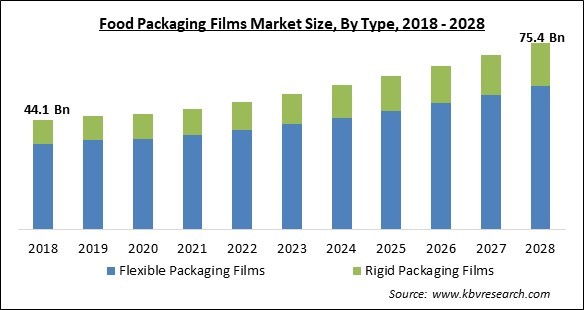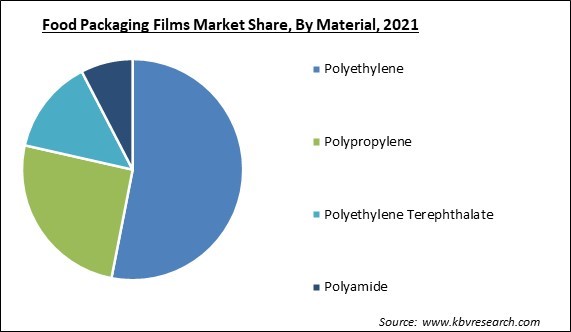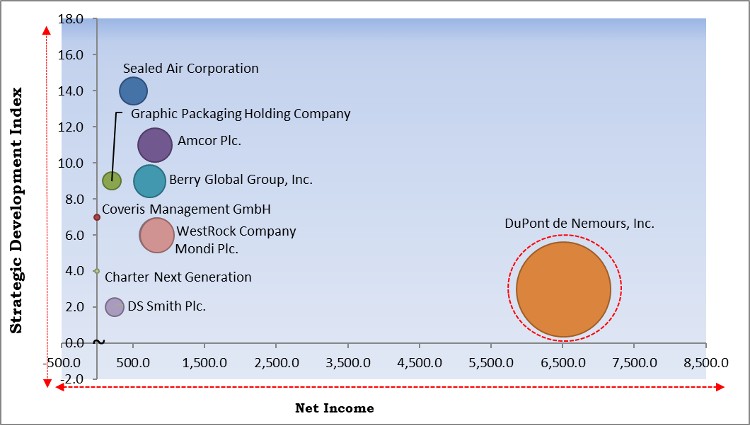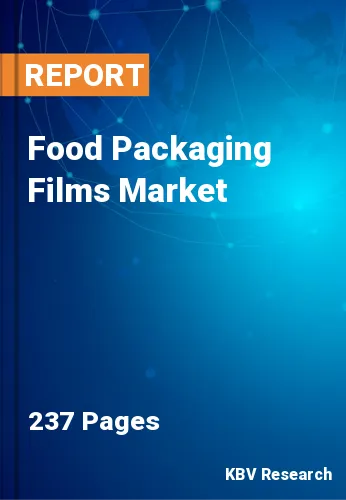The Global Food Packaging Films Market size is expected to reach $75.4 billion by 2028, rising at a market growth of 6.5% CAGR during the forecast period.
A thin plastic film commonly used for sealing food items in containers to preserve their freshness for a longer length of time is known as food packaging film. Food packaging film can maintain its tight fit over a container's opening without adhesive since it sticks to many smooth surfaces and is often supplied on rolls in packages with a forefront of technology.

The average piece of food packaging film is around 0.0005 inches (12.7 mm) thick. The majority of brands on store shelves today are 8, 9, or 10 m thick due to the trend of producing thinner food packaging film, especially for home use. Polyvinyl chloride (PVC), the material that was originally used to make the plastic wrap, is still the most widely used substance worldwide. PVC helps in keeping food fresh by having an appropriate low permeability to oxygen and water vapor.
Concerns exist regarding the penetration of plasticizers from PVC entering food. In the middle of the 20th century, pliofilm, made of several types of rubber chloride, was utilized because it could be heat-sealed. Low-density polyethylene is a typical substitute for PVC that is less expensive. It is less sticky than PVC, but this drawback can be overcome by including linear low-density polyethylene, which also boosts the tensile strength of the film.
The COVID-19 pandemic caused severe damage to the economy all over the world. Various businesses witnessed a steep downfall due to the advent of the COVID-19 pandemic. Moreover, governments all over the world were compelled to impose lockdown in their countries, due to which, manufacturing facilities of a number of products were temporarily shut down. The outbreak of the infection also caused a significant impact on the food packaging film market. Due to the industrial closure, the production of these films was significantly hampered. In addition, due to the restrictions on imports and exports, packaged food items along with packaging films were hampered.
Governments all around the world are making an emphasis on lowering environmental pollution and enticing end-use industries to choose environmentally friendly options. In several developed as well as developing countries, there are stringent rules about plastic dumps. Packaging businesses are emphasizing on eco-friendly solutions for environmental sustainability due to the growing concerns about environmental degradation. The three Rs of eco-friendly packaging viz. renew, reuse, and recycle, are the standards by which green packaging items must abide.
One of the major factors that are fueling the growth of the food packaging films market is the increasing consumption of packaged convenience food all over the world. With an increase in technology as well as the rapid expansion of urbanization, the lifestyles of modern people are increasingly becoming hectic. The food consumption patterns have shifted majorly in recent years. Due to shifting food consumption patterns along with rising urbanization, convenience food is the market sector in food packaging films that is expanding at a very rapid pace.
Sustainability and the reduction of resources utilized in a product's packaging are closely related, as is the decrease of waste produced by packaging materials. It has to do with finding the best primary, secondary, or tertiary material combinations in order to reduce the volume of primary materials used in the initial production process. By employing fewer materials, manufacturers have been focusing on lowering the size and weight of the packaging. Packaging waste is being reduced as a result of this trend toward smaller packaging.

Based on Type, the Food Packaging Films Market is bifurcated into Flexible Packaging Films and Rigid Packaging Films. In 2021, the flexible packaging film segment acquired the highest revenue share of the food packaging films market. The increased growth of the segment is primarily owing to the fact that this type of film can be easily used in the transportation of food items. Any box or component of a package that can easily alter shape is considered flexible packaging.
On the basis of Material, the Food Packaging Films Market is segmented into Polyethylene, Polypropylene, Polyethylene Terephthalate, and Polyamide. In 2021, the polypropylene segment procured a substantial revenue share of the food packaging films market. The fluctuation in humidity has no effect on this substance. It has a greater barrier to water vapor and a moderate permeability to gases and smells.
By Application, the Food Packaging Films Market is segregated into Fruits & Vegetables, Bakery & Confectionery, Meat, Poultry & Seafood, Convenience Foods, Dairy Products, and Others. In 2021, the meat, poultry, & seafood segment witnessed the biggest revenue share of the food packaging films market. Food packaging films are mostly used for meat products. The need for food packaging in this market is being driven up by rising health concerns and an increased understanding of the nutritional benefits of meat products. Packaging protects food from contamination brought on by diseases, germs, and other microbes.
| Report Attribute | Details |
|---|---|
| Market size value in 2021 | USD 48.8 Billion |
| Market size forecast in 2028 | USD 75.4 Billion |
| Base Year | 2021 |
| Historical Period | 2018 to 2020 |
| Forecast Period | 2022 to 2028 |
| Revenue Growth Rate | CAGR of 6.5% from 2022 to 2028 |
| Number of Pages | 237 |
| Number of Tables | 383 |
| Report coverage | Market Trends, Revenue Estimation and Forecast, Segmentation Analysis, Regional and Country Breakdown, Competitive Landscape, Companies Strategic Developments, Company Profiling |
| Segments covered | Type, Material, Application, Region |
| Country scope | US, Canada, Mexico, Germany, UK, France, Russia, Spain, Italy, China, Japan, India, South Korea, Singapore, Malaysia, Brazil, Argentina, UAE, Saudi Arabia, South Africa, Nigeria |
| Growth Drivers |
|
| Restraints |
|
Region-wise, the Food Packaging Films Market is analyzed across North America, Europe, Asia-Pacific, and LAMEA. In 2021, Asia-pacific accounted for the largest revenue share of the food packaging films market. The market in the region is being driven by elements, like a large population, a rise in the demand for convenience food items, the availability of low-cost raw materials for packaging, and an increase in health consciousness. The majority of food packaging film is produced in China and these factors are boosting the growth of the segment.
Free Valuable Insights: Global Food Packaging Films Market size to reach USD 75.4 Billion by 2028

The major strategies followed by the market participants are Acquisitions. Based on the Analysis presented in the Cardinal matrix; DuPont de Nemours, Inc. is the major forerunner in the Food Packaging Films Market. Companies such as Amcor Plc., Berry Global Group, Inc. and Sealed Air Corporation are some of the key innovators in Food Packaging Films Market.
The market research report covers the analysis of key stake holders of the market. Key companies profiled in the report include Amcor Plc., Berry Global Group, Inc., Sealed Air Corporation, Coveris Management GmbH (Sun Capital Partners, Inc.), Mondi Plc., DuPont de Nemours, Inc., DS Smith Plc., WestRock Company, Graphic Packaging Holding Company and Charter Next Generation.
By Type
By Material
By Application
By Geography
The Food Packaging Films Market size is projected to reach USD 75.4 billion by 2028.
Increasing efforts of market players in the introduction of new eco-friendly products are driving the market in coming years, however, Rising emphasis of food packagers on the reduction of packaging size restraints the growth of the market.
Amcor Plc., Berry Global Group, Inc., Sealed Air Corporation, Coveris Management GmbH (Sun Capital Partners, Inc.), Mondi Plc., DuPont de Nemours, Inc., DS Smith Plc., WestRock Company, Graphic Packaging Holding Company and Charter Next Generation.
The expected CAGR of the Food Packaging Films Market is 6.5% from 2022 to 2028.
The Polyethylene market is leading the Global Food Packaging Films Market by Material in 2021; thereby, achieving a market value of $37.8 billion by 2028.
The Asia Pacific market shows high market share in the Global Food Packaging Films Market by Region in 2021; thereby, achieving a market value of $28.7 billion by 2028.
Our team of dedicated experts can provide you with attractive expansion opportunities for your business.

